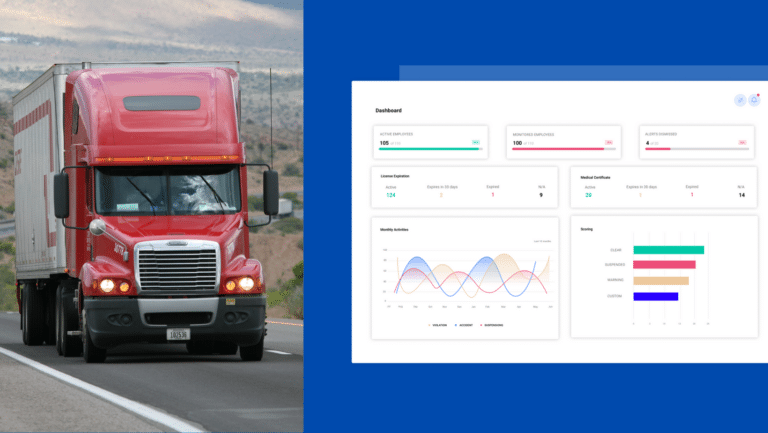Improving Driver Retention: Key Strategies for Fleet Managers

Driver retention continues to be one of the top challenges faced by organizations. Large truckload carriers’ turnover rates often skyrocket to 90-100% annually. This means that if a company employs 100 drivers, they might see 90 to 100 of them leave over the course of a year. Smaller carriers also struggle, with rates hovering around 70-80%.
With driver retention being such a critical issue, what can companies do to improve their strategies and keep their drivers on the road?
Why Are Drivers Leaving?
According to the U.S. Bureau of Labor Statistics, driving is one of the most dangerous jobs due to its nature and challenges.
Truck drivers often work long, irregular hours, spending weeks away from home, which takes a toll on their personal and family lives. The job itself is highly sedentary, leading to various health problems such as obesity, hypertension, and diabetes due to limited access to healthy food and exercise options.
Additionally, many drivers feel they need to be paid and receive adequate benefits. High-stress levels from tight deadlines, traffic, and demanding working conditions further contribute to driver dissatisfaction.
Although driver retention is a daunting task for companies, the cost of hiring new drivers is significantly more than the cost of retaining current ones, highlighting the importance of addressing these issues.
Key Strategies and Best Practices To Improve Driver Retention

1. Offer Competitive Compensation and Benefits
Let’s be honest—money talks. If drivers feel they’re not being paid what they’re worth, they’ll find someone who will.
One of the primary reasons drivers leave their jobs is inadequate pay. Offering competitive wages, bonuses, and comprehensive benefits can significantly improve retention.
According to a survey by the National Transportation Institute, carriers offering higher pay packages saw a 10-15% improvement in retention rates. Benefits such as health insurance, retirement plans, and paid time off also play a crucial role in job satisfaction and driver retention.
2. Recognize and Reward Good Driving
Who doesn’t love a little recognition? Acknowledging employees’ hard work and dedication is essential to improving driver retention.
Recognition programs that include awards for clean driving records, safe driving, on-time deliveries, and customer satisfaction can motivate drivers to stay with the company and keep up the hard work.
According to a survey by OnePoll on behalf of Bonusly, almost half of U.S. workers (46%) left a job because they felt unappreciated. Another 65% of respondents said they would work harder if they felt like their contributions were noticed by management.
If you notice something positive, say something. A kind word, a thank-you letter, or even a small gift can go a long way in making employees feel valued.
3. Encourage Open Communication and Feedback
We all know communication is key, regardless of the industry. Keeping open lines of communication between drivers and management can make a huge difference.
Don’t wait until year-end to discuss performance or critical issues with your drivers. Regular check-ins and feedback sessions ensure drivers feel valued and heard.
Utilizing technology like MVR monitoring, which provides near real-time data on new MVR convictions and suspensions, allows managers to offer instant feedback, which is crucial for maintaining driver satisfaction and safety standards. Prompt feedback enables managers to acknowledge safe driving practices, address potential issues such as traffic violations or accidents, and guide employees toward corrective actions immediately.
Remember, feedback is a two-way street. While it’s important for management to provide constructive feedback to drivers, it’s equally important to listen to their feedback. Drivers, being on the front lines, can offer valuable insights into operational challenges and areas for improvement.
Read more: 5 Safety Messaged For Drivers To Reduce Accidents
4. Invest In The Safety Of Your Team
Ensuring the safety of your drivers is not just about compliance—it’s about showing that you genuinely care about their well-being.
The foundation of a good safety program starts with thorough onboarding. When new drivers join your team, setting clear expectations and providing comprehensive training is essential. This includes educating them on safety protocols, company policies, and best practices on the road.
Equip your drivers with advanced safety tools to ensure they have the resources they need to operate safely and effectively. Modern safety technology can significantly reduce the risk of accidents and improve overall driver performance.
5. Health and Wellness Programs
Driving can be tough on the body and mind. The demands of long hours on the road and the need to stay alert and focused can lead to fatigue, stress, and overall health challenges.
Offering health and wellness programs that include access to fitness facilities, health screenings, and mental health resources can really improve your drivers’ quality of life.
The Journal of Occupational and Environmental Medicine found that companies with wellness programs see a 17% reduction in turnover rates. It’s all about taking care of your drivers, inside and out.
Happy employees equal higher driver retention
Keeping your drivers happy and engaged takes effort, but it’s worth it. To improve your driver retention strategy, focus on key areas like competitive pay, work-life balance, recognition, professional development, safety, communication, and wellness.
Investing in your drivers isn’t just good practice; it’s a smart move that can lead to a more stable, efficient, and successful operation. Your drivers will thank you, and so will your bottom line.
Want to learn more about our driver safety solutions? Book a demo or explore MVR Monitoring, Fleet Training, DQF Manager






